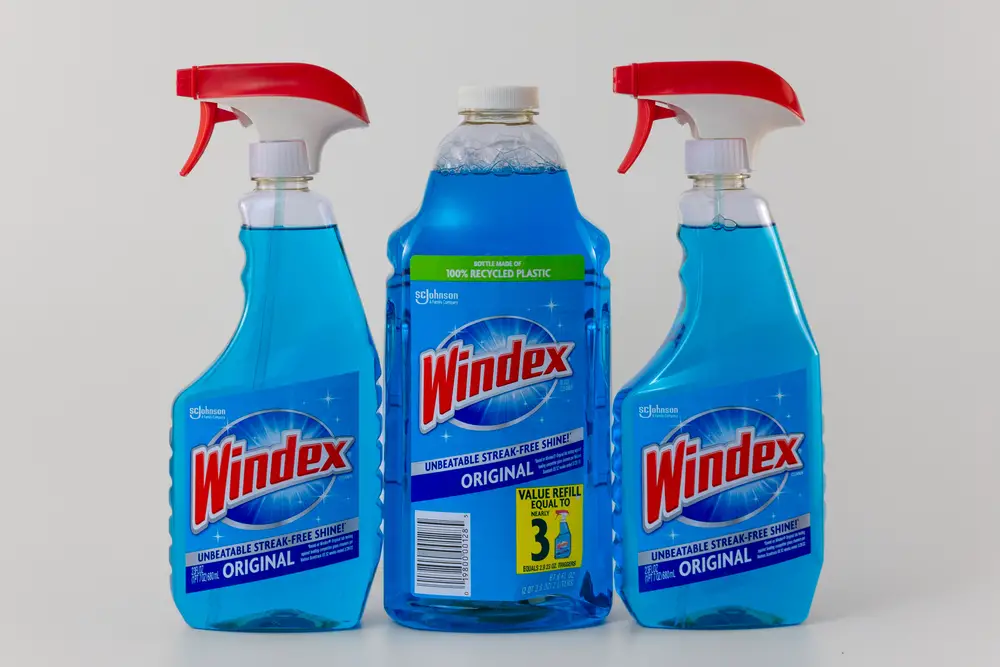Termites are notorious for causing damage to wooden structures, furniture, and homes. Homeowners constantly seek various prevention and extermination methods to counter the havoc these tiny insects wreak.
One such solution that has piqued the interest of many is the use of Windex, a household cleaning agent usually reserved for cleaning windows and other surfaces, as a means to eliminate termites.
Quick Answer:
Windex may kill some termites on contact due to its ammonia content, but it’s not an effective solution for termite control. It won’t reach termites within wood or underground, so professional pest control methods and specialized insecticides are advised.
What Are Termites?
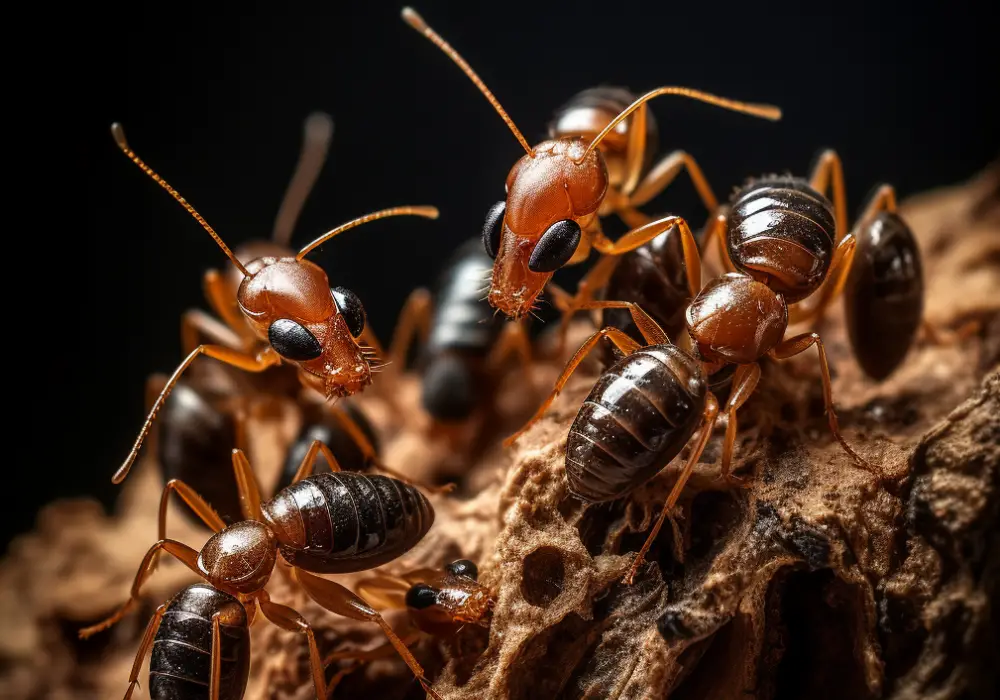
Termites are small insects that belong to the order Isoptera. These insects are typically known for their wood-consuming behavior, causing considerable damage to homes and structures around the world.
Termites can be separated into several groups, with the most common being drywood termites, subterranean termites, and dampwood termites.
Drywood termites are found in warm and dry environments. They live entirely inside the wood they consume, and unlike other termite species, they don’t require direct contact with soil for their survival. As a result, drywood termite infestations usually affect furniture, wooden structures, and even the foundations of buildings.
Subterranean termites are among the most common and destructive types of termites. They build extensive tunnel systems underground and within walls to maintain a suitable, moist environment. Subterranean termites are highly adaptable and can be found in various regions, including secluded areas and urban spaces.
Dampwood termites thrive in areas with high moisture content, like rotting logs, tree stumps, and damp wooden structures. Unlike their drywood counterparts, dampwood termites require constant contact with water and moist soil for their survival.
An additional termite species of concern is the Formosan termite, a highly aggressive type of subterranean termite that’s native to eastern Asia. Formosan termites are known for their large colonies, which can number in the millions, and their ability to cause significant damage in a relatively short period.
Termites typically swarm as part of their reproductive cycle. During a swarm, winged termites known as alates leave their nests to mate and establish new colonies. Swarms usually occur in the spring or early summer, depending on the species and the climatic conditions.
Proper identification of termite swarms is crucial in detecting infestations early and preventing further damage to structures.
Life Cycle of Termites
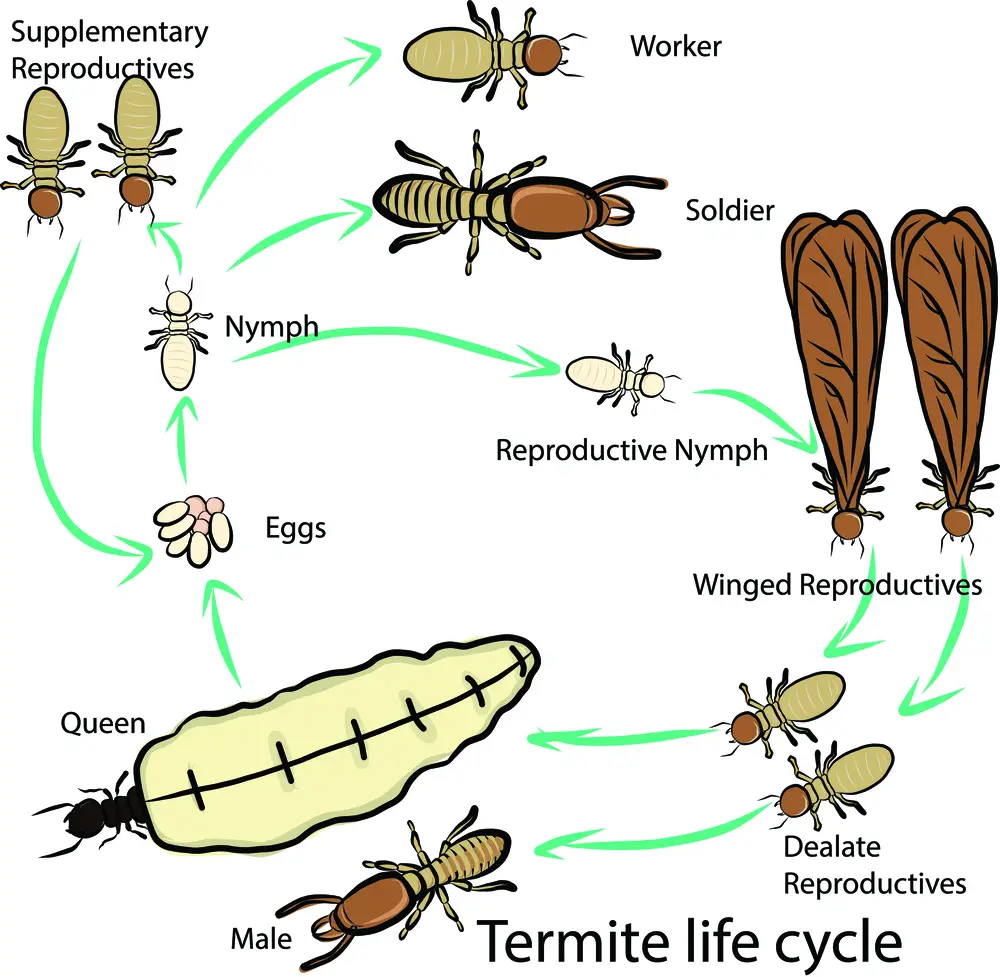
Termites are social insects that live in large colonies. The life cycle of termites involves three main stages: egg, nymph, and adult. These stages can vary between different termite species but generally follow the same pattern.
The life cycle begins when the queen of the termite colony lays her eggs. Depending on the species, a queen can lay hundreds or thousands of eggs in a single day. The eggs then hatch into small, white nymphs.
These nymphs undergo a series of molting processes to grow and develop into one of the three main termite castes: workers, soldiers, and reproductives.
Workers make up the majority of the termite colony. They are responsible for foraging, food gathering, building and maintaining the nest, caring for the eggs and nymphs, and providing protection from predators.
Workers are usually blind and wingless, making them well-adapted to life inside the dark, humid colony.
Soldiers serve as the colony’s defense system against potential threats. They have large, strong mandibles adapted for combat and produce defensive chemicals to repel predators. Soldiers are also blind and wingless but are generally larger than the workers.
Reproductives, which include the queen and king termites, are responsible for reproduction and expansion of the colony. They are the only members of the colony that have fully functional wings and eyes. After a nuptial flight, they mate and form a new termite colony, beginning the life cycle once again.
Infestations occur when new termite colonies establish themselves near or within human structures. These structures provide ample food sources and shelter, allowing the termite colony to thrive and grow rapidly.
Over time, the damage caused by these infestations can be severe, often leading to costly repairs and the potential collapse of the infested structures.
Identifying the signs of a termite colony early on is crucial in preventing extensive damage and the growth of infestations.
Some common indicators include:
- Mud tubes on the exterior of the structure
- Hollow-sounding or damaged wood
- Discarded termite wings near windows or doors
- Visible termite swarms
Termite Infestation Signs
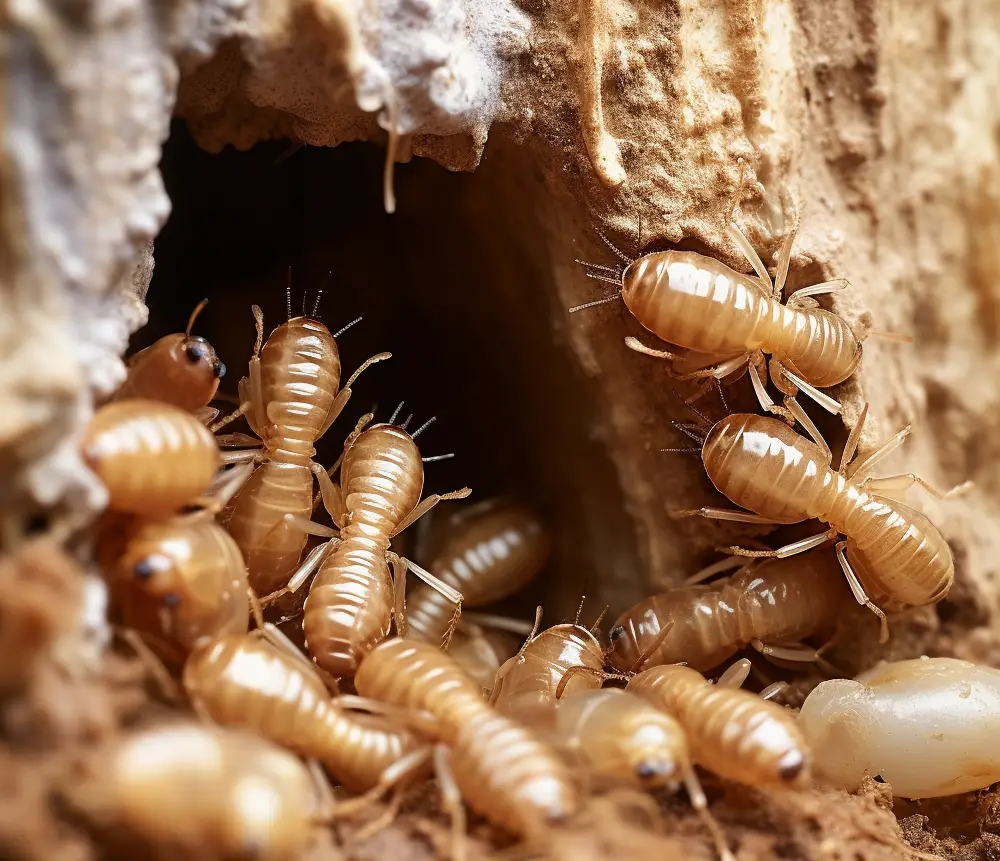
Termites are notorious for their destructive behavior, causing millions of dollars in property damage each year. It’s vital to recognize the signs of a termite infestation early on to mitigate the extent of the damage.
Here are some common signs of termite infestation:
Mud Tubes: Termites use mud tubes to travel between their underground nests and food sources, such as the wooden structures of your house. These tubes, typically the width of a pencil, are made of soil and debris and can often be found along foundations or in crawl spaces.
Wings: Reproductive termites, or swarmers, have wings that they shed after finding a mate. If you discover discarded wings around your home, it may be a sign that termites have recently swarmed and could be starting a new colony nearby.
Termite Droppings: Termites produce small, pellet-like droppings, also known as frass. If you notice these in or around your home, it could indicate a termite infestation. Termite droppings can be found near mud tubes, in crawl spaces, or around termite nests.
Hollow Wood: Termites eat away at the cellulose in wood, which may leave a hollow or papery sound when tapped. Be sure to inspect wooden structures around your home for any signs of hollowness or unexplained damage.
Termite Damage: Termites often eat wood from the inside out, so look for small holes or crumbling in your home’s woodwork or structural components. Additionally, warped door frames or sagging floors can also be signs of termite damage.
Commonly Used Termite Treatments
Termite infestations can cause serious damage to buildings and homes, so it is essential to address them as soon as possible.
There are a variety of termite treatments available, and this section will discuss some of the most common ones.
Insecticides are a common method for killing termites. These pesticides are typically applied as a barrier around the property to prevent termites from entering.
Common insecticides used for termite treatments include fipronil, imidacloprid, and permethrin. These chemicals work by disrupting the central nervous system of the termites, ultimately leading to their death.
Termite baits are another popular treatment option and involve placing bait stations containing pesticide-laden materials around the property.
The bait’s active ingredient, hexaflumuron, inhibits the termites’ ability to molt, which eventually causes their death. Termites will also share the bait with their colony members, leading to a more widespread eradication of the infestation.
Fumigation is a more aggressive treatment option that involves sealing a building or structure and releasing a gas that is toxic to termites. This method is often used when infestations are more extensive and require a fast and comprehensive solution.
Fumigation is a highly effective method for eradicating termites, but it is also costly and may require the occupants to vacate the premises for a period of time.
Natural Methods to Dispose of Termites
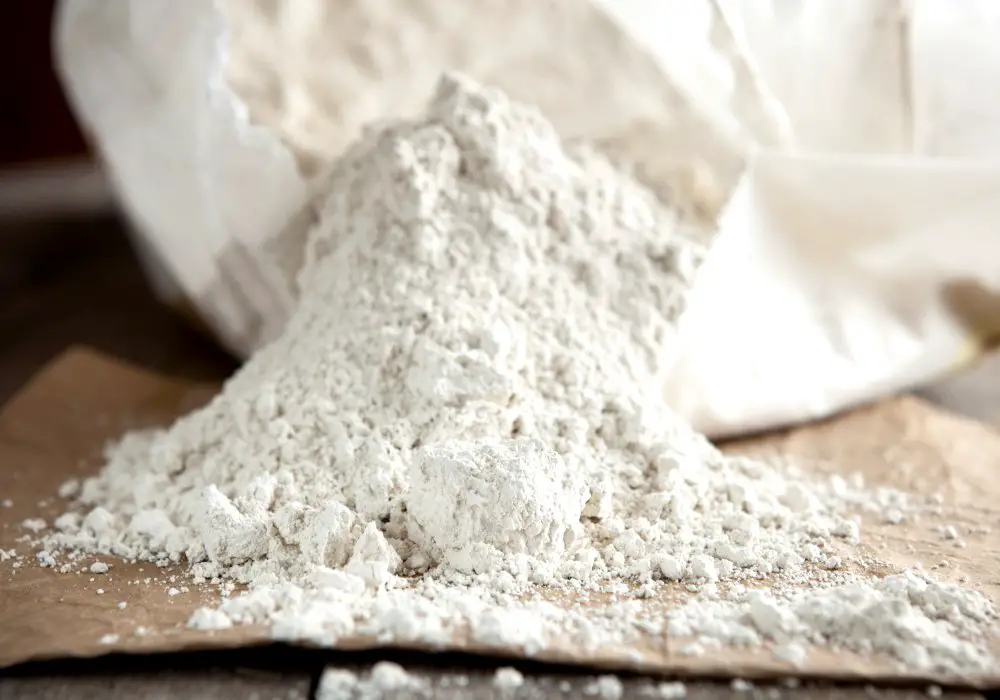
Termites can cause significant damage to your property if left untreated. Fortunately, there are several natural methods available to help you get rid of termites effectively.
These methods include the use of nematodes, essential oils, diatomaceous earth, cardboard traps, and vinegar.
Nematodes: These are tiny, worm-like creatures that feed on termites. Beneficial nematodes can be purchased from garden supply stores or online retailers. To use nematodes to control termites, simply mix them with water and apply the solution to areas where termites are present.
Nematodes will seek out and kill the termites, helping to reduce their population.
Essential oils: Some essential oils, such as orange oil or neem oil, have been found to be effective in controlling termites. To use essential oils, mix a few drops with water and spray the solution on affected areas or termite entry points.
Regular application will help deter termites from infesting your property.
Diatomaceous earth: This natural, abrasive powder is made from fossilized aquatic organisms called diatoms. Diatomaceous earth can be used to eliminate termites by causing them to dehydrate and die.
Simply sprinkle the powder in areas where termites are active, such as around the foundation of your home or within termite-infested wood.
Cardboard trap: A simple yet effective method for capturing termites involves the use of a wet cardboard trap. Soak a piece of cardboard in water and place it in an area where termites are known to be present.
The cellulose in the cardboard will attract termites, and once they gather on the trap, you can collect and dispose of them.
Vinegar: Vinegar is a household staple that can be used to repel termites. Mix equal parts white vinegar and water, and spray the solution on areas where termites are active. Reapply the solution as needed to keep termites at bay.
Role of Household Products in Termite Control
Household products, such as Windex and other ammonia-based cleaners, have been considered by some as potential DIY methods for termite control.
This idea stems from the fact that termites are known to be sensitive to various chemicals, and people often look for affordable and accessible solutions when faced with a termite infestation.
Windex, a popular glass and hard surface cleaner, contains around 5-10% of ammonia, which is a powerful cleaning agent. Ammonia is known to be effective at breaking down and removing organic materials, and it has been suggested that it may be able to kill or deter termites due to its high pH level and strong odor.
However, there is no scientific evidence to support the use of Windex or ammonia as a reliable termite control method.
Moreover, other household cleaners and products may also be ineffective or even detrimental in the battle against termites. While some DIY methods may provide temporary relief, they might not address the root of the problem, potentially allowing termites to regroup and continue to cause damage.
Is Windex A Reliable Termite Killer?
Windex is a popular cleaning solution that many people use around the house for various purposes. However, when it comes to using Windex as a termite killer, it’s important to consider its effectiveness and potential side effects.
- One 23 fl oz bottle of Windex Original Glass Cleaner is a great home and car window cleaner solution that leaves an unbeatable streak-free shine**
- Window cleaner spray comes in a recycled plastic bottle made of 100% Recovered Coastal Plastic* in partnership with Plastic Bank
- This home and car glass cleaner starts working on smudges, dirt, fingerprints and other messes even before you wipe
There is a common myth that Windex can be toxic to pests, which might be the basis for people to consider using it as a termite killer. It’s true that Windex contains chemicals that could potentially be harmful to insects, such as ants, wasps, spiders, and bed bugs.
Using Windex against termites may not provide the desired results for a number of reasons. Termites are known to be resilient pests that can withstand certain chemicals.
Additionally, termites live in colonies and may be hidden deep within the wood structures, making it difficult for a household cleaning solution like Windex to reach them and effectively eliminate them.
Moreover, it’s important to consider the potential negative effects of using Windex as a termite killer. While it might be toxic to some pests, it may not have the same effect on termites.
Consequently, using Windex for this purpose could unnecessarily expose your home and the surrounding environment to harmful chemicals.
It is also crucial to note that Windex is not designed or labeled to be used as a pesticide. For this reason, relying on Windex as a termite killer may not be the safest or most effective option.
Potential Harm from Using Windex
Windex is a household cleaner primarily designed for cleaning glass surfaces. While it may have some effect on termites, it is not specifically designed as a pesticide.
Resorting to Windex for termite control could potentially cause harm to humans, pets, and children in the following ways:
First, Windex contains chemicals that could be harmful if ingested, inhaled, or if it comes into contact with skin in excessive amounts. Using it as a termite control method might require increased exposure to these chemicals, which could lead to health issues if not handled with caution.
Symptoms of Windex exposure can include respiratory irritation, eye irritation, and skin burns in severe cases.
Second, applying Windex as a termite control solution might lead to the contamination of surfaces where food is prepared, increasing the risk of accidental ingestion.
Moreover, children and pets, who are more susceptible to the harmful effects of chemicals, might not have the same awareness as adults to steer clear of treated areas and could accidentally come into direct contact with the chemicals.
Lastly, relying on Windex for termite control could provide a false sense of security, as it might not effectively eliminate or control termite infestations. In turn, this could lead to further damage to property and furnishing, ultimately causing financial and emotional strain for homeowners.
Professional Pest Control for Termites

Termites can pose a severe threat to the structural integrity of buildings and homes; thus, professional pest control is essential. Termite control requires a combination of regular inspection, effective eradication strategies, and preventive measures to minimize the chances of re-infestation.
An initial inspection by a professional pest control service is crucial to identify the extent of the termite problem. Professionals use specialized tools and techniques to locate termite colonies and gauge damage.
They also assess the risks and recommend the best course of action to tackle the infestation.
Chemical treatments are often employed to provide a barrier between the termites and the property. Expert pest control professionals are well-versed in the correct use of these treatments, ensuring maximum effectiveness and safety.
Another method of termite eradication can include the use of baiting systems, where poisoned bait is strategically placed, luring termites away from the property and eventually causing colony elimination.
Hiring professional pest control services is the most reliable way to deal with a termite infestation. These professionals have access to a range of tools, equipment, and knowledge to tackle termite problems efficiently.
Additionally, they are aware of the latest advancements and regulations pertaining to termite control, ensuring your property’s protection adheres to current standards.
Preventive Measures Against Termites
Taking preventive measures against termites is essential for homeowners looking to protect their properties from potential infestations and the resulting structural damage. By addressing the factors that attract termites to homes and creating a physical barrier, homeowners can significantly reduce the risk of an infestation.
Termites thrive in moist environments, so controlling moisture levels around your home is crucial.
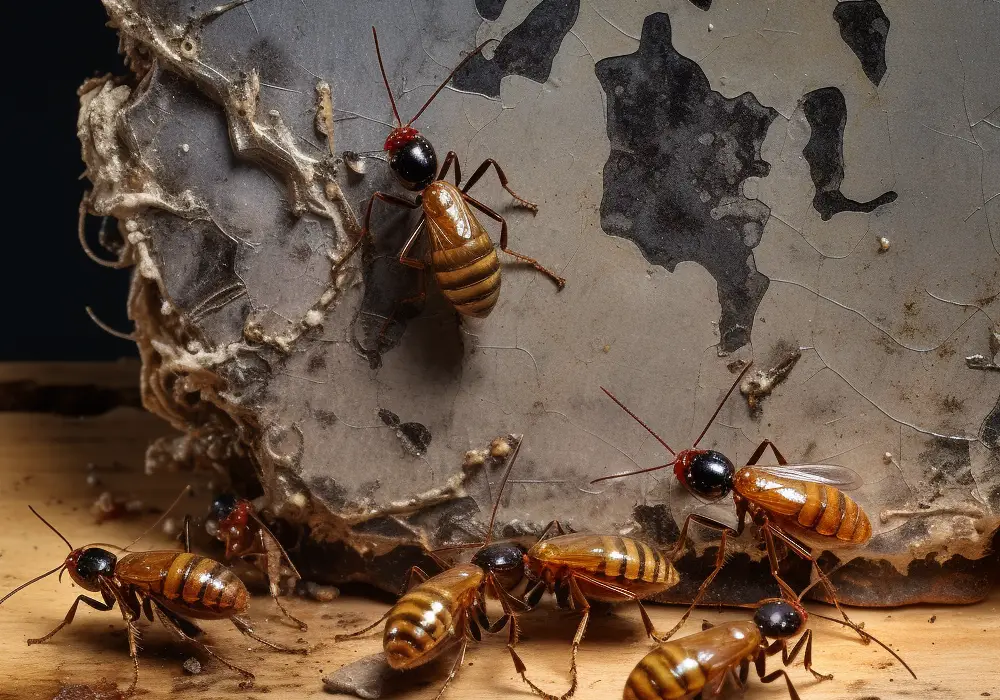
Check for leaks in your plumbing and roof, and fix any issues promptly. Keep gutters clean and well-maintained to avoid water pooling near your home’s foundation. Proper ventilation of crawl spaces and attics is also important to reduce humidity levels and discourage termites from settling in these areas.
Landscaping and maintaining the area around your home can also have an impact. Avoid planting trees too close to your house, as their roots can create pathways for termites to reach the structure.
Also, make sure to properly maintain and trim your trees, keeping branches away from the exterior of your home. Fill any cracks and crevices in your home’s foundation, walls, and windows with caulk to eliminate potential entry points for termites.
Regularly inspect and seal openings around pipes and utilities to further discourage the pests.
Keeping firewood, wood debris, and mulch away from your home helps reduce the chances of attracting termites. Store firewood at least 20 feet away from your home and elevate it off the ground to minimize contact with moisture and soil.
Avoid stacking wood against your home’s foundation, and keep your lawn clean of fallen branches and leaves.
Installing a physical barrier, such as steel mesh or sand barriers, around your home’s foundation can help prevent termites from gaining access to the structure.
Applying wood treatments to susceptible areas, such as exposed wooden beams and crawl spaces, can also deter termites. Creating a termiticide barrier around your home is another effective prevention measure, which involves applying a liquid termiticide to the soil surrounding the structure.
This creates a chemical barrier that kills or repels termites, preventing infestations.

